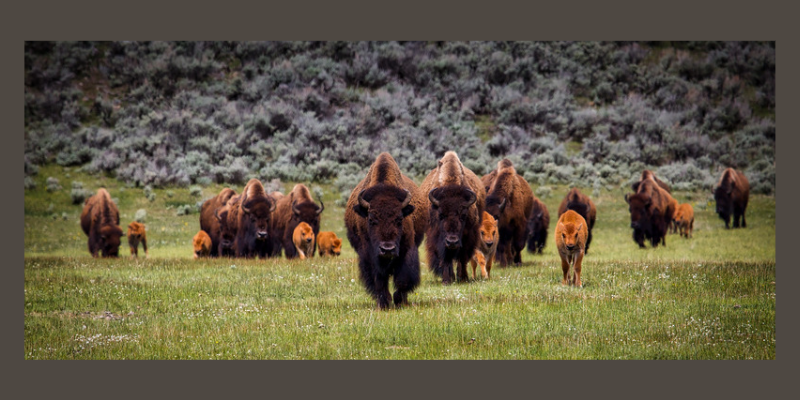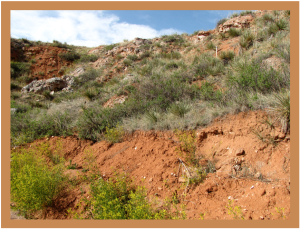Gazing at the IMMENSE hole of a buffalo jump in Beulah, Wyoming (as described in the previous post), I suddenly saw a relationship between making it easy to process buffalo for winter and making it easy for kids to learn.
To explain, let me start with a few questions:
Do you remember when you were in school?
- Were you sometimes bored?
- Were you uninterested in what had to be memorized?
- Did it seem that school work was disconnected from “real life”?
- Would you ask your teacher, “Why do I have to do this?“
If so, you are not alone.
For me, school often felt a twelve year sentence—with no chance of parole! Occasionally, there would be a flash of interest, an insightful teacher, a momentary experience of discovery, but that was certainly not the norm. Mostly, we were shuffled from one class to another, regardless of interest, until graduation.
You may be one of the lucky few who do not relate to this, but thousands upon thousands of homeschooling parents have agreed in workshops that this was their experience.
When we try to teach our own children at home, these school-days experiences can come back to haunt us. Here sit our precious offspring, yawning, their eyes glazed over, and asking, “Mommy, do we HAVE to do this?” Ouch! We understand exactly what they mean, but we don’t know how to make their experience different from ours.
 Buffalo Jumps in Learning
Buffalo Jumps in Learning
In contrast to the yawning, glazed-eye student, have your children ever been totally self-motivated to learn about something? Whether baseball, dead bugs, piano, or how to make fried ice cream, they were eager, rarin’ to go, and couldn’t wait to know!
That, my friends, is a Buffalo Jump. Your student’s natural hunger to discover and learn is one of the most powerful forces that you will ever find! The trick is to recognize it when it is happening (or to offer opportunities for it to happen), and then allow the full “weight” of their curiosity to propel them deep into whatever they are learning.
Here’s an example:
Twenty-two years ago, after we had moved from the West Coast to South Dakota, my nine-year old son asked me, “Mom, why do steel ships float?”
Nowadays, this would be a no-brainer. An iPhone, a quick Google search, and an answer. But not in 1992.
With out a single steel ship in sight, I was sunk.
But then, I did what homeschoolers used to do all the time. “I don’t know the answer to your great question, Michael, but I know where we can go to find out!”
And, with great expectations, we sailed off to the library. When the librarian was asked, “Excuse me, do you know why steel ships float?”, she looked around in dismay. Evidently, that question was not real common in South Dakota.
“Hmmm… Try this book.” It was a college level book on boat building, and way beyond me. I slunk out of the library, kids in tow, still clueless.
Never one to give up, my son kept asking the question: “Why do steel ships float?”
We looked through other books at home. We looked high, we looked low. We looked through every book we thought might have the answer. Still clueless.
It got so we were asking everyone we met, “Excuse me, but do you know why…?”
After two weeks of searching, late one night I remembered a box of books in the closet. “Mmmm. I wonder…” I sprang from the bed to the box, found a book on how things work by Reader’s Digest, and quickly turned to the index. Incredibly, I saw this listing, “Why steel ships float”. EUREKA! Our answer was at hand.
As the whole family learned about the principle of buoyancy, about surface tension, and about the ancient scientist/mathematician/inventor Archimedes, we thought up several creative ideas for experiments with lead fishing weights. We pounded and dropped and observed and recorded. By the time it was done, Michael’s curiosity about why steel ships float had motivated the whole family to jump into exploring with him, learning things beyond our ken and certainly beyond our lesson book!
Opportunities Abound!
Many, many dinner table discussions have resulted in perusing encyclopedias, requesting library books, searching internet listings, and questioning experts. Questions have come up during mathematics that were totally off the point but worth pursuing nonetheless. Ideas have been generated during car rides that require lots of thinking and discussing. There have been on-the-spot opportunities to learn while having an x-ray (How can you tell if my finger is broken?); while eating at a Chinese restaurant (What was your home like in China?); while visiting a cattle ranch (Where did those brands come from?).
These moments, when someone wonders, “why?” or, “when?” or, “how?” or, “who?” or, “what if,” are the Buffalo Jumps. They present the perfect opportunities to use the tremendous force of natural curiosity to propel a student into interesting, meaningful learning.
Just as the buffalo jumps were used as an effective, efficient means of procuring meat for the tribe, so are the buffalo jumps of learning a very effective, efficient means of getting knowledge into a child. Rather than the few inches of refuse found in normal archaeological sites, the buffalo jump in Wyoming provided archaeologists with more than twenty feet of “stuff”! In the same way, learning that is motivated by a hunger to know—where the student rushes headlong into it—is far more productive; it leaves far more evidence of knowledge acquired than the normal method of “read the chapter and answer the questions in the back.”
Motivating Them
“Okay, okay. But will our children, on their own, EVER fall into one of these educational buffalo jumps?”
Good question! The buffalo, ambling along on their own, wouldn’t have just fallen in. The Plains tribes skillfully used their knowledge. They knew where the buffalo were and the location of the jump. All they needed was to move the herd in that general direction, and at the appropriate moment, “motivate” them! The natural law of gravity took care of the rest.
So, in buffalo jumps of learning, the parent is the one who knows where their students are in skill level, in experience, and in ability. A parent, spying out the land, will also be aware of what sorts of things really interest their children, whether it has to do with inventions, or biographies, or sports, or crafts, or hands-on experiments, or drama, or whatever it might be. What the parent can do is to begin moving the students toward a possible area of interest, and, at the appropriate moment, motivate some excitement into that area (in other words, activate their natural curiosity.)
Here are some suggestions:
- find a fantastic book in the library and read a few chapters out loud (like Carry On, Mr. Bowditch);
- watch a YouTube video which shows how cathedrals were built in the Middle Ages (like “Cathedral“ by David Macaulay);
- take a field trip to see a sculptor sculpting;
- visit a veteran who fought in a war;
- go to a symphony performance of Peter and the Wolf;
and much, much more.
These motivating moments, that you help provide, will get those children stampeding right smack into real learning! Then all you have to do is stand by, ready to assist.
That, dear friends, is learning like a buffalo!
Remember, stay relational.
Diana




